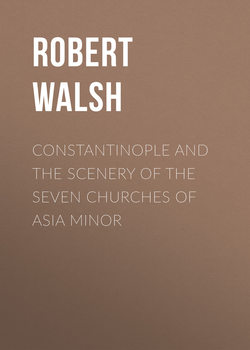Читать книгу Constantinople and the Scenery of the Seven Churches of Asia Minor - Robert Walsh - Страница 1
PREFACE
ОглавлениеNothing can form a stronger contrast in modern times, than Asiatic and European Turkey. The first preserves its character unchanged−men and things still display the permanency of Oriental usages; and they are now as they have been, and will probably continue to be, for an indefinite period.
Not so the second−Constantinople having for centuries exhibited the singular and extraordinary spectacle of a Mahomedan town in a Christian region, and stood still while all about it were advancing in the march of improvement, has at length, as suddenly as unexpectedly, been roused from its slumbering stupidity; the city and its inhabitants are daily undergoing a change as extraordinary as unhoped for; and the present generation will see with astonishment, that revolution of usages and opinions, during a single life, which has not happened in any other country in revolving centuries.
The traveller who visited Constantinople ten years ago, saw the military a mere rabble, without order or discipline, every soldier moving after his own manner, and clad and armed after his own fashion; he now sees them formed into regular regiments, clothed in uniform, exercised in a system of tactics, and as amenable to discipline as a corps of German infantry. He saw the Sultan, the model of an Oriental despot, exhibited periodically to his subjects with gorgeous display; or to the representatives of his brother sovereigns, gloomy and mysterious, in some dark recess of his Seraglio: he now sees him daily, in European costume, in constant and familiar intercourse with all people−abroad, driving four-in-hand in a gay chariot, like a gentleman of Paris or London; and at home, receiving foreigners with the courtesies and usages of polished life. He formerly saw his kiosks with wooden projecting balconies, having dismal windows that excluded light, and jalousies closed up from all spectators; he now sees him in a noble palace, on which the arts have been exhausted to render it as beautiful and commodious as that of a European sovereign. He formerly saw the people listening to nothing, and knowing nothing, but the extravagant fictions of story-tellers; he now sees them reading with avidity the daily newspapers published in the capital, and enlightened by the realities of passing events.
It is thus that the former state of things is hurrying away, and he who visits the capital to witness the singularities that marked it, will be disappointed. It is true, it possesses beauties which no revolution of opinions, or change of events, can alter. Its seven romantic hills, its Golden Horn, its lovely Bosphorus, its exuberant vegetation, its robust and comely people, will still exist, as the permanent characters of nature: but the swelling dome, the crescent-crowned spire, the taper minaret, the shouting muezzin, the vast cemetery, the gigantic cypress, the snow-white turban, the beniche of vivid colours, the feature-covering yasmak, the light caïque, the clumsy arrhuba, the arched bazaar−all the distinctive peculiarities of a Turkish town−will soon merge into the uniformity of European things, and, if the innovation proceed as rapidly as it has hitherto done, leave scarce a trace behind them.
To preserve the evanescent features of this magnificent city, and present it to posterity as it was, must be an object of no small interest; but the most elaborate descriptions will fail to effect it.
It is, therefore, to catch the fleeting pictures while they yet exist, and transmit them in visible forms to posterity, that the present work has been undertaken, and, that nothing might be wanting, Asiatic subjects are introduced; thus presenting, not only the Turk of one region as he was, but of another as he is, and will continue to be.
The Views are accompanied with letter-press, describing the usages, customs, and opinions of the people, as ancillary to the pictorial representations; and a Map of the Bosphorus is added, pointing out localities, and directing attention to the spot on which the reality stood or still stands. To complete the whole, an historical sketch of the city from its foundation is annexed, with a chronological series of its Emperors and Sultans to the present day; thus combining a concise history of persons and events, with copious details of its several parts, and vivid and characteristic representations of its objects.
ROBERT WALSH.
